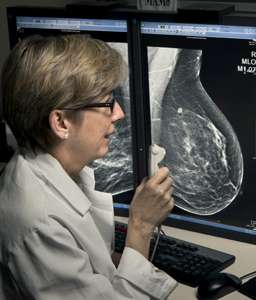3-D mammography detects more invasive cancers and reduces call-back rates

Reporting in the June 25 issue of JAMA, researchers from Penn Medicine and other institutions found that 3D mammography—known as digital breast tomosynthesis— found significantly more invasive, or potentially lethal, cancers than a traditional mammogram alone and reduced call-backs for additional imaging. This is the largest study reported to date—with nearly a half a million women—measuring the effectiveness of the technology, and could potentially lead to a change in the standard of care for breast screening.
"It's the most exciting improvement to mammography that I have seen in my career, even more important for women than the conversion from film-screen mammography to digital mammography," said senior author Emily F. Conant, MD, chief of Breast Imaging the department of Radiology at the Perelman School of Medicine at the University of Pennsylvania. "3D mammography finds more clinically significant breast cancers earlier, which is the key so that women have moretreatment options and ultimately better health outcomes."
In the retrospective study, the researchers looked at 281,187 digital mammography examinations and 173,663 examinations with both tomosynthesis and digital mammography between 2010 and 2012. The data set included women from a wide range of breast cancer screening programs that were both geographically diverse and included both academic and community practices, 13 in total.
Researchers found 41 percent more invasive cancers when women were screened with tomosynthesis plus digital compared to digital mammography alone. The use of tomosynthesis also reduced the number of women called back for unnecessary screenings due to false alarms by 15 percent.
Conventional digital mammography is the most widely-used screening modality for breast cancer, but may yield suspicious findings that turn out not to be cancer, known as false-positives. Such findings are associated with a higher recall rate, or the rate at which women are called back for additional imaging or biopsy that may be deemed unnecessary.
Tomosynthesis, however, allows for 3-D reconstruction of the breast tissue, giving radiologists a clearer view of the overlapping slices of breast tissue. And though a relatively new technology, it has shown promise at reducing recall rates in all groups of patients, including younger women and those with dense breast tissue, and better detection rates in smaller studies. In 2011, tomosynthesis was approved by the U.S. Food and Drug Administration to be used in combination with standard digital mammography for breast cancer screening.
3D mammography is the only method used for breast cancer imaging that has demonstrated this combined benefit, the authors report. While 3D mammography found more invasive cancers, detection of in situ cancers (non-invasive cancers) was similar to a traditional mammography.
Since October 2011, all screening mammograms at Penn Medicine's Perelman Center for Advanced Center now include tomosynthesis according to Dr. Conant.
"The coming years will be very exciting, as we see further improvements in this innovative technology," said Conant. "This new technology will certainly change the way we screen women."
More information: JAMA, DOI: 10.1001/jama.2014.6095 and DOI: 10.1001/jama.2014.6421













